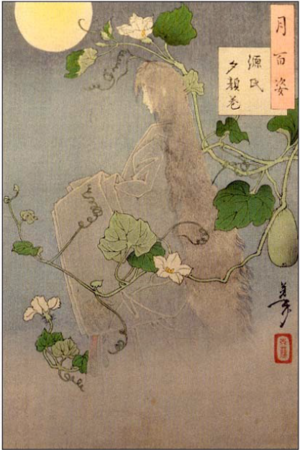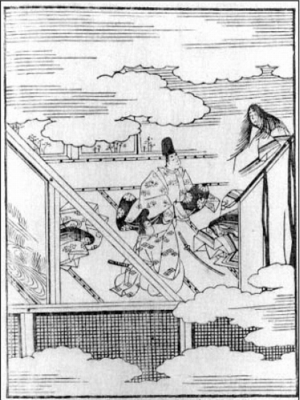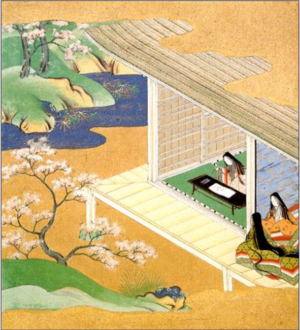Exzerpt:Bargen 1997: Unterschied zwischen den Versionen
PG (Diskussion | Beiträge) |
PG (Diskussion | Beiträge) |
||
| Zeile 9: | Zeile 9: | ||
==Inhalt== | ==Inhalt== | ||
| − | |||
| − | |||
| − | |||
| − | |||
[[Bild:Buch A woman`s weapon.PNG|left|thumb|A woman`s weapon: spirit possession in the Tale of Genji]] | [[Bild:Buch A woman`s weapon.PNG|left|thumb|A woman`s weapon: spirit possession in the Tale of Genji]] | ||
| − | + | [[Genji Monogatari]] von [[Murasaki Shikibu]] geschrieben in der Heian Periode (794-1186) | |
| − | + | Bargen analysiesert die Darstellungen von weiblichen Geistern und die Bessesseneheit von weiblichen Figuren | |
| + | ===mono no ke === | ||
| + | Dämonen, böse Gister und Gespenster (jp. ''mono no ke'' 物の怪 もののけ) ergriefen besitz von Frauen | ||
===Yugao in Yugao (Evening Faces)=== | ===Yugao in Yugao (Evening Faces)=== | ||
| Zeile 25: | Zeile 23: | ||
|The specific scene most frequently illustrated in later Genjie | |The specific scene most frequently illustrated in later Genjie | ||
captures the moment that precipitated the fleeting love affair between Genji and Yugao: a white gourd flower (yugao: Lagenaria siceraria) is passed over on a fan that, according to the text, is embellished by a waka, a thirtyonesyllable poem in the phonetic kana script known in Heian times as onnade, literally, woman's hand. | captures the moment that precipitated the fleeting love affair between Genji and Yugao: a white gourd flower (yugao: Lagenaria siceraria) is passed over on a fan that, according to the text, is embellished by a waka, a thirtyonesyllable poem in the phonetic kana script known in Heian times as onnade, literally, woman's hand. | ||
| − | |quelle = ''Barger_2016'' page32 | + | |quelle = ''Barger_2016'' page32}} |
| − | }} | ||
[[Bild:Yagao.PNG|left|thumb|Yagao]] | [[Bild:Yagao.PNG|left|thumb|Yagao]] | ||
Version vom 3. April 2019, 19:30 Uhr
Seite ist in Bearbeitung!!!
die Autorin
Doris G. Bargen PhD ist emeritierte Professorin und ehemalige Direktorin des Ehrenprogrammes an der University of Massachusetts Amherst. Ihre Forschungsinteressen reichen von klassischer, mittelalterliche und modernen japanischen Literatur und Kultur bis hin zu japanischer Kunst und Architektur. Sie erreichte internationale Bekanntheit durch ihre Arbeit am Genji Monogatarie.
Inhalt
Genji Monogatari von Murasaki Shikibu geschrieben in der Heian Periode (794-1186) Bargen analysiesert die Darstellungen von weiblichen Geistern und die Bessesseneheit von weiblichen Figuren
mono no ke
Dämonen, böse Gister und Gespenster (jp. mono no ke 物の怪 もののけ) ergriefen besitz von Frauen
Yugao in Yugao (Evening Faces)
Geschichte: eine von vielen Liebesaffairen von Genji
captures the moment that precipitated the fleeting love affair between Genji and Yugao: a white gourd flower (yugao: Lagenaria siceraria) is passed over on a fan that, according to the text, is embellished by a waka, a thirtyonesyllable poem in the phonetic kana script known in Heian times as onnade, literally, woman's hand.
]
Aoi in Aoi (Heartvine)
Murasaki in wakana ge (New Herbs: Part Two)
die dritte Prinzessin in kashiwag (The Oak Tree)
Ukifune in tenarai (At Writing Practice)
Quelle
- [1] (Stand: 2019/04/02).



